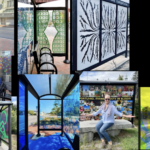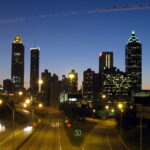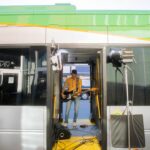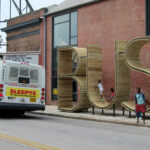In the 1990s, a coalition of more than 80 Puerto Rican community organizations and business leaders came together to prevent displacement of their community in the West Town neighborhood. In collaboration with elected leaders and the city, the group established “Paseo Boricua” and erected two 9-foot, steel Puerto Rican flag sculptures which still stand today and signal the corridor’s identity and also physically claim the space as Puerto Rican.
The challenge
Chicago has long had a Puerto Rican population, but it was only in the recent decades that the community found a more permanent home within the city. In the 1960s and 1970s, Puerto Rican residents were displaced from a series of neighborhoods by an influx of affluent whites and ended up relocating to West Town and Humboldt Park.1 In the 1990s, community leaders feared another wave coming to West Town and came together to do something about it. A coalition of more than 80 Puerto Rican community organizations and business leaders formulated a master plan to prevent another wave of displacement by using the political and economic tools of development to their advantage.
The project
The group decided to focus their efforts on a mile-long stretch along Division Street between Western Avenue and Mozart Avenue where just over half of the buildings were owned by Puerto Ricans and other Latinos. Their goal was to further concentrate Puerto Rican-owned businesses in the area, expand affordable housing, and protect businesses and residents alike from being displaced through rising rents and property taxes.
Having organized and established more political representation than Puerto Ricans had in the past, local leaders gained support from the City of Chicago for their efforts to establish a Puerto Rican enclave that came to be known as “Paseo Boricua” (loosely translated as “Puerto Rican Promenade”). In 1995, the city solidified this support with a gift that is now the neighborhood’s hallmark feature: two 59-foot, steel Puerto Rican flag sculptures, crossing Division Street at either end of the commercial strip.
The Paseo Boricua Flags established an identity for the corridor and also physically helped to claim the space as Puerto Rican. The flags were part of a series of city initiatives in the Humboldt Park neighborhood. Additional efforts included:
- Providing matching funds to improve business façades to resemble Old San Juan colonial buildings;
- Enabling tax-increment financing as a redevelopment tool; and
- Attracting developers and local financing to match programs such as Low Income Housing Tax Credit, HOME and Community Development Block Grants to build over one hundred units of affordable housing.
Local leaders say the flag statues played a critical role in establishing Paseo Boricua as the central economic, cultural and political focal point for the community.

The results
“Business sales have increased 30 percent in Paseo Boricua since the flags were unveiled,” wrote scholar Nilda Flores-Gonzalez in 2001 research. In the first year after the flags were installed, 16 new businesses opened, and by the end of the decade, the corridor boasted more than 90 businesses and organizations.
Decades later, the flags continue to protect. Though the adjacent neighborhoods have changed dramatically, rents have increased nearby, and Puerto Rican businesses have been displaced around the corridor, the stretch of Paseo Boricua between the statues still serves as the community’s understood focal point, boasting a variety of distinctly Puerto Rican businesses, multiple affordable housing units, nonprofits, and political offices that serve Puerto Rican constituencies.
In 2014, the Puerto Rican Cultural Center celebrated the launch of it’s five-year strategic plan to “preserve and support the Puerto Rican community in Humboldt Park” with the purchase of a former sausage house that they planned to convert into a cultural hub and housing.2 Most recently, in 2020—after community groups planning and organizing for the past twenty years—Chicago Mayor Lori Lightfoot “issued an ordinance to allocate an additional $6 million in tax-exempt housing bonds” toward an arts building that will house 45 units of affordable housing and a ground-floor theater.
Key partners: Puerto Rican Cultural Center, City of Chicago
- Encyclopedia of Chicago. Puerto Ricans. Retrieved from https://bit.ly/3dVPLZM
- Darryl Holliday. (October 6, 2014). Former Sausage Warehouse Acquired to House New Arts Center in Humboldt. DNA Info. Retrieved from https://www.dnainfo.com/chicago/20141006/humboldt-park/former-sausage-warehouse-acquired-house-new-arts-center-humboldt/














